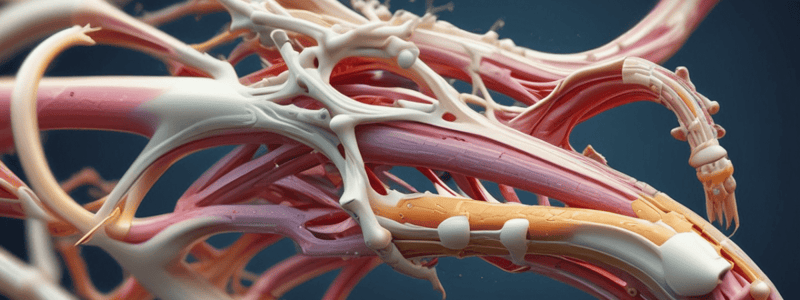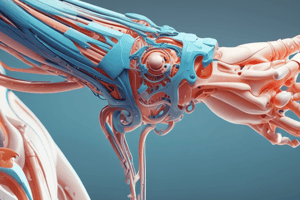Podcast
Questions and Answers
Chondrocytes are nourished by blood vessels.
Chondrocytes are nourished by blood vessels.
False (B)
Fibrocartilage is a mixture of dense connective tissue and articular cartilage.
Fibrocartilage is a mixture of dense connective tissue and articular cartilage.
False (B)
Fibrocartilage is primarily located in the intraarticular discs of extremities.
Fibrocartilage is primarily located in the intraarticular discs of extremities.
True (A)
Chondrocytes and fibroblasts are the main cells found in fibrocartilage.
Chondrocytes and fibroblasts are the main cells found in fibrocartilage.
Aneural tissues have a rich blood supply.
Aneural tissues have a rich blood supply.
Fibrocartilage provides the resilience and shock absorption of articular cartilage.
Fibrocartilage provides the resilience and shock absorption of articular cartilage.
Fibrocartilage's primary function is to provide muscle contraction.
Fibrocartilage's primary function is to provide muscle contraction.
Bone is considered a specialized connective tissue.
Bone is considered a specialized connective tissue.
Chondrocytes can repair themselves easily when damaged.
Chondrocytes can repair themselves easily when damaged.
Type II fibers are thicker and stiffer than type I fibers.
Type II fibers are thicker and stiffer than type I fibers.
Elastin fibers create a netlike interweaving of small fibrils.
Elastin fibers create a netlike interweaving of small fibrils.
Tissues with a high proportion of elastin do not return to their original shape after being deformed.
Tissues with a high proportion of elastin do not return to their original shape after being deformed.
Ground substance is a water-saturated matrix that contains only elastin fibers.
Ground substance is a water-saturated matrix that contains only elastin fibers.
Glycosaminoglycans (GAGs) are neutrally charged and repel water.
Glycosaminoglycans (GAGs) are neutrally charged and repel water.
Water in periarticular connective tissues provides a solid medium for nutrient diffusion.
Water in periarticular connective tissues provides a solid medium for nutrient diffusion.
Cells in periarticular connective tissues are responsible for maintaining and repairing the tissues.
Cells in periarticular connective tissues are responsible for maintaining and repairing the tissues.
Skeletal muscle cells provide significant mechanical properties to periarticular connective tissues.
Skeletal muscle cells provide significant mechanical properties to periarticular connective tissues.
Type I fibers provide a flexible woven framework for maintaining the general shape of structures like hyaline cartilage.
Type I fibers provide a flexible woven framework for maintaining the general shape of structures like hyaline cartilage.
The movement of one articular surface on another is under voluntary control.
The movement of one articular surface on another is under voluntary control.
If the joint structures are tight, the joint will have too much play and become instable.
If the joint structures are tight, the joint will have too much play and become instable.
According to the Convex-Concave Rule, for a convex-on-concave surface movement, the convex member rolls and slides in the same directions.
According to the Convex-Concave Rule, for a convex-on-concave surface movement, the convex member rolls and slides in the same directions.
For a concave-on-convex surface movement, the concave member rolls and slides in opposite directions.
For a concave-on-convex surface movement, the concave member rolls and slides in opposite directions.
During abduction without a concurrent inferior slide, the humeral head can impinge against the arch.
During abduction without a concurrent inferior slide, the humeral head can impinge against the arch.
In a close-packed position, ligaments and the capsule are not pulled taut.
In a close-packed position, ligaments and the capsule are not pulled taut.
A joint in a close-packed position is resistant to tensile forces that tend to cause distraction of the joint surfaces.
A joint in a close-packed position is resistant to tensile forces that tend to cause distraction of the joint surfaces.
Active range of motion refers to the maximum force exerted by extensors in the middle range.
Active range of motion refers to the maximum force exerted by extensors in the middle range.
The knee joint is an example of a ball and socket shape joint.
The knee joint is an example of a ball and socket shape joint.
Impure swing involves pure back and forth movement around a fixed pivot point in one plane.
Impure swing involves pure back and forth movement around a fixed pivot point in one plane.
A knee joint that is relatively externally rotated when fully extended has combined movements of roll-and-slide.
A knee joint that is relatively externally rotated when fully extended has combined movements of roll-and-slide.
Degrees of freedom in joint movement represent the number of independent movements allowed at a joint.
Degrees of freedom in joint movement represent the number of independent movements allowed at a joint.
The end feel in range of motion (ROM) assessment refers to the amount of muscle force exerted at the end of a movement.
The end feel in range of motion (ROM) assessment refers to the amount of muscle force exerted at the end of a movement.
External force by a therapist moving one articular surface relative to another is used to assess the amount of joint play.
External force by a therapist moving one articular surface relative to another is used to assess the amount of joint play.
Physiological barrier refers to the limit determined by the end feel in a joint's active range of motion.
Physiological barrier refers to the limit determined by the end feel in a joint's active range of motion.
Passive range of motion involves maximum force exerted by flexors in the inner range.
Passive range of motion involves maximum force exerted by flexors in the inner range.
Spin in osteokinematics refers to rotation around a joint axis.
Spin in osteokinematics refers to rotation around a joint axis.
Side-to-side translation is an example of angular motion in osteokinematics.
Side-to-side translation is an example of angular motion in osteokinematics.
A tissue that is elongated beyond its physiologic range eventually reaches its yield point.
A tissue that is elongated beyond its physiologic range eventually reaches its yield point.
Increased strain results in only marginal increased stress (compression).
Increased strain results in only marginal increased stress (compression).
The physical behavior of an overstretched tissue is known as elasticity.
The physical behavior of an overstretched tissue is known as elasticity.
Zone C of the stress-strain curve represents the plastic zone.
Zone C of the stress-strain curve represents the plastic zone.
Plastic energy is fully recoverable when the deforming force is removed.
Plastic energy is fully recoverable when the deforming force is removed.
Most healthy tendons fail at about 20-25% beyond their prestretched length.
Most healthy tendons fail at about 20-25% beyond their prestretched length.
Young’s modulus defines the resistance offered by a material to external loads.
Young’s modulus defines the resistance offered by a material to external loads.
When a structure can no longer support a load, it is said to have reached its yield point.
When a structure can no longer support a load, it is said to have reached its yield point.
Ultimate stress is the strain at the point of failure of a material.
Ultimate stress is the strain at the point of failure of a material.
Flashcards are hidden until you start studying
Study Notes
Chondrocytes and Cartilage
- Chondrocytes are nourished by blood vessels, allowing for cellular health and repair.
- Fibrocartilage combines dense connective tissue with articular cartilage, providing structural support.
- Located primarily in intraarticular discs of extremities, fibrocartilage aids in joint function.
- Key cell types in fibrocartilage include chondrocytes and fibroblasts, essential for maintenance and repair.
Tissue Properties and Functions
- Aneural tissues, despite lacking nerve supply, have a rich blood circulation for nutrient delivery.
- Fibrocartilage offers resilience and shock absorption, essential for joint protection and mobility.
- The primary function of fibrocartilage is to facilitate muscle contraction and maintain joint stability.
- Bone, categorized as specialized connective tissue, plays a crucial role in structural support and movement.
Fiber Composition and Properties
- Type II fibers are thicker and stiffer than type I fibers, providing durability to cartilage.
- Elastin fibers create a flexible network; tissues high in elastin do not return to their original shape after deformation.
- Ground substance is a water-saturated matrix critical for nutrient diffusion and tissue hydration.
- Glycosaminoglycans (GAGs) are negatively charged, playing a role in maintaining fluid balance in tissues.
Joint Mechanics
- The movement of one articular surface over another is mainly under voluntary control.
- Tight joint structures can lead to instability as they allow excessive play.
- According to the Convex-Concave Rule, convex-on-concave movements result in rolling and sliding in the same direction, while concave-on-convex movements slide in opposite directions.
- During specific movements like abduction, without appropriate slides, impingement can occur (e.g., the humeral head against the arch).
Joint Position and Motion
- A close-packed joint position has taut ligaments and resists tensile forces, stabilizing joint surfaces.
- Active range of motion is the maximum force exerted by extensors during movement, representing functional capacity.
- The knee joint is an example of a ball-and-socket joint, allowing multi-directional movement.
- Degrees of freedom in joint movement denote the number of independent motions permitted at a joint.
Range of Motion Assessment
- End feel in range of motion refers to the resistance felt at the limit of movement, influenced by muscle force.
- Joint play can be assessed by external forces applied by a therapist to one articular surface relative to another.
- The physiological barrier signifies limits set by the end feel in an active range of motion assessment.
- Passive range of motion is the maximum force exerted by flexors in their inner range, indicating muscle-tendon integrity.
Stress-Strain Relationships
- Spin in osteokinematics describes rotation around a joint axis, while side-to-side translation is an example of angular motion.
- Tissues elongated beyond their physiological range will eventually reach a yield point, indicating structural integrity limit.
- Increased strain leads to marginal increases in stress, showing the relationship between deformation and load.
- Elasticity of overstretched tissues is defined by their ability to return to original form.
- Zone C of the stress-strain curve indicates the plastic zone where permanent deformation occurs.
Material Properties
- Plastic energy can be fully recovered once the deforming force is stripped away.
- Tendons typically fail at 20-25% beyond their prestretched length, underscoring limits of flexibility and strength.
- Young’s modulus quantifies a material's resistance to external loads, reflecting its mechanical properties.
- The yield point indicates failure when a structure can no longer support applied loads, leading to ultimate stress reflected at the material's failure point.
Studying That Suits You
Use AI to generate personalized quizzes and flashcards to suit your learning preferences.




